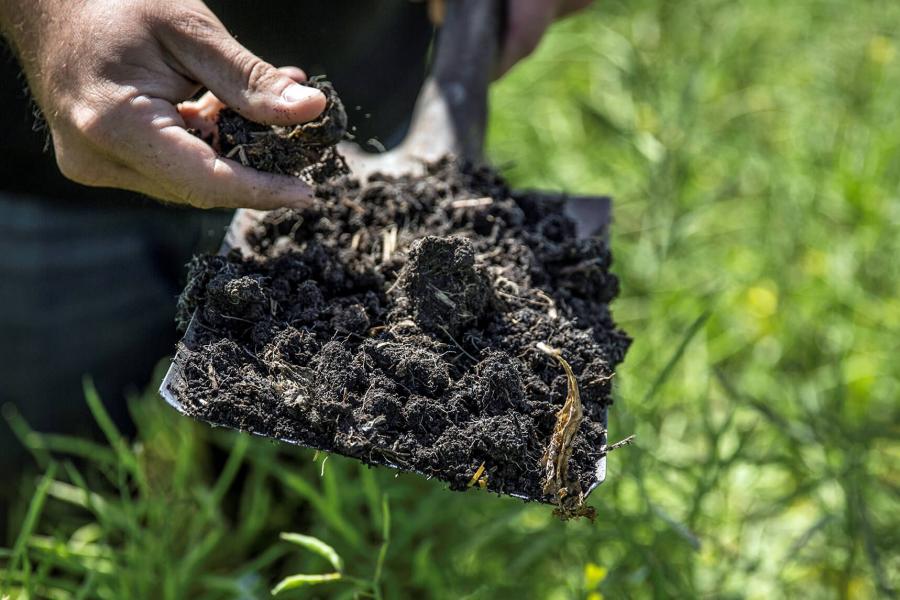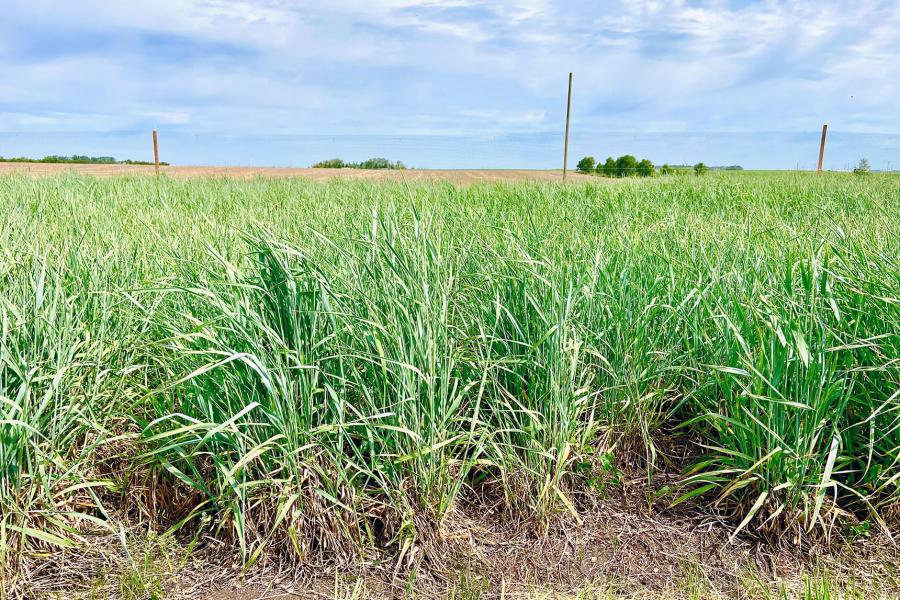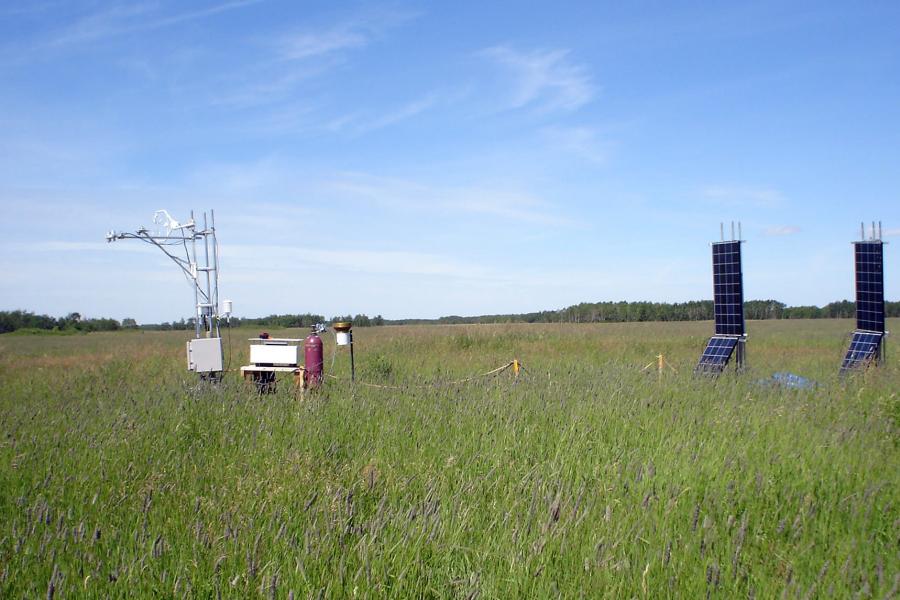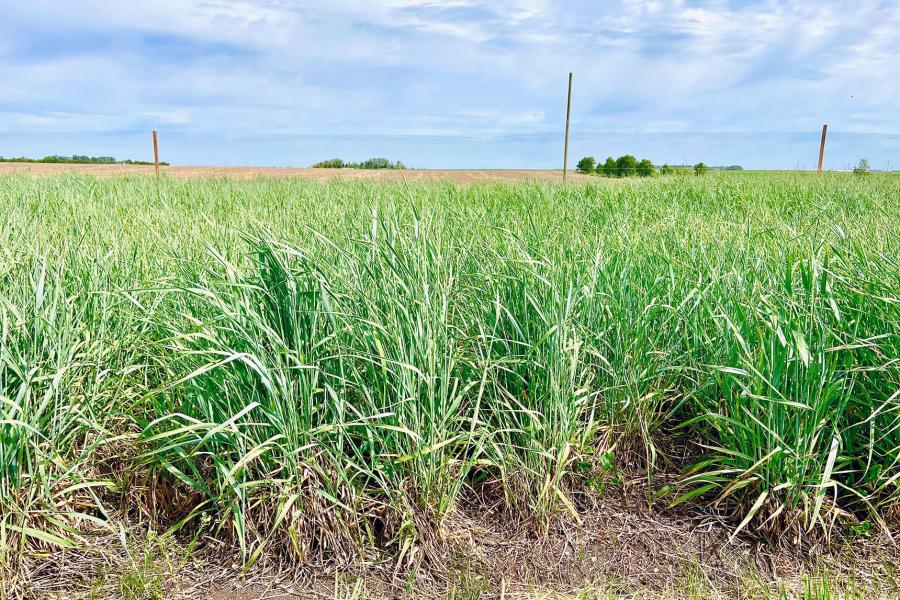Livestock as an agroecosystem solution
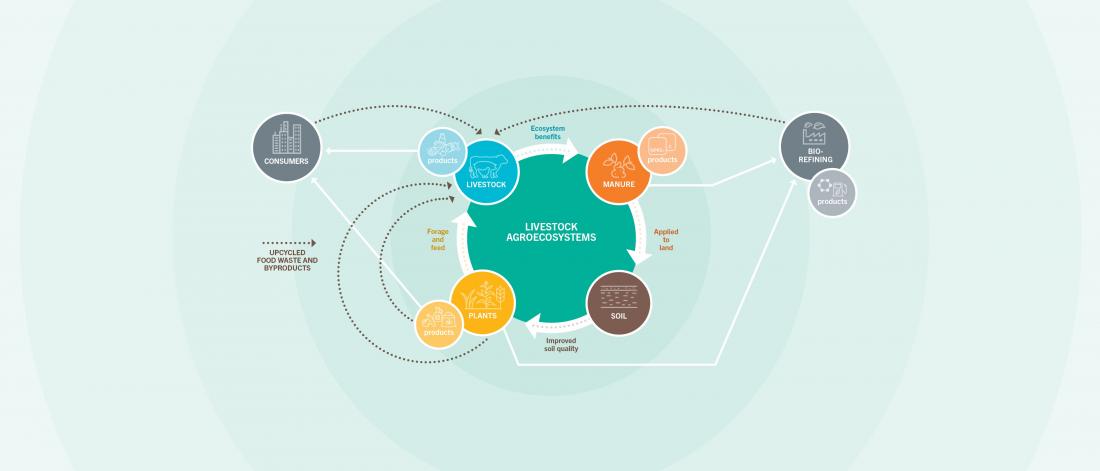
Enhancing livestock's role in sustainable food production systems
As Canada seeks new ways to manage its environmental footprint, many opportunities can be found in the livestock sector. Through beneficial management practices, livestock production can play a significant role in soil improvement, sustainable land use and greenhouse gas mitigation, while at the same time providing high-quality protein.
The National Centre for Livestock and the Environment helps maximize these opportunities by looking at livestock production in the context of our shared food system, which includes crop production, wildlife habitat and the continuous cycling of nutrients and biomass within the ecosystem. Their work provides a deeper understanding of how the diverse elements of the agro-ecosystem can work together, and how farmers can optimize the levers within their control.
Agroecosystem research areas
- Crop-livestock integration at landscape, local, and regional scales
- Climate change resiliency in crop and livestock systems
- Climate-related impacts on plants, animals and insects
- 4R principles for manure and fertilizer use
- Organic production systems using plant and livestock nutrients
- Human sources of nutrients for crop production
- Livestock manure in cropping systems for healthy, productive soils
- Pollinator and wildlife habitats in livestock and cropping systems
Asking the big questions, seeing the big picture
Managing manure like the valuable resource it is
Too often, manure and other livestock by-products are considered a problem – something to be disposed of. But the National Centre for Livestock and the Environment (NCLE) sees these nutrient-rich organic materials in a totally different light.
To NCLE researchers, manure is loaded with potential to feed plants, reduce erosion, and improve the water-retaining capacity of soil. They see it as a precious source of macro- and micronutrients, as well as organic matter and potential benefits that science may yet discover.
Read more
For more than a decade, NCLE researchers and partners have been shedding light on how manure can be used more effectively as the valuable resource nature intended it to be. They study the whole nutrient cycle, from how the plants eaten by animals determine the amount of nutrients in their manure, to how manure nutrients move within the ecosystem once applied to soil. The cycle also includes the nutrients exported from farms as food and other products – nutrients that farms must eventually replace.
“It’s what we call the circular bioeconomy,” says Don Flaten, professor emeritus, who was part of the core team that created NCLE. “Animals consume and contribute nutrients in the cycle, plants take those nutrients in, animals eat the plants, and the cycle continues.
“The distinctive feature of the Faculty of Agricultural and Food Sciences is its strengths in all of these areas – so it is the ideal base for an organization like NCLE. Scientists from different disciplines work together to understand the whole system.”
The end result of this work is scientifically sound, locally relevant research outcomes, shared with livestock and crop sectors.
Here’s a quick look at how some of these studies have evolved.
Long-term field laboratory: a unique research asset
The hub of NCLE’s manure research is the NCLE long-term field laboratory at the University of Manitoba’s Glenlea Research Station. To the uninitiated, this site may look like a simple collection of over 100 field plots. But there’s much more going on here than meets the eye.
Since 2007, the site has been running continual studies comparing the impact of different types of manure and management practices under different cropping systems. It is truly a laboratory – one that a wide variety of researchers can use to study a broad range of manure-related topics, drawing on the extensive archives of soil, manure and crop samples, and data that have been gathered here since its beginning.
Researchers have used the important element of time to develop a deeper understanding of how nutrients move into the root zone, how soil conditions affect their availability to crops, and whether they may move into the environment in potentially harmful ways. Data is captured about management impacts and long-term sustainability that could not be easily measured in short-term studies.
“Some nutrients in manure are available to plants right away, and some take awhile. That’s why it’s important to have a long-term research site like this,” says Flaten, who played a key role in establishing the field lab in the early days of NCLE.
Manure research happens in many places, but what sets the NCLE field laboratory apart is the range of manure types that have been studied here – from semi-solid dairy cattle manure, to liquid pig manure, to solid pig manure from pigs raised on straw.
“We also wanted to go beyond a single type of cropping system, so we included perennial forages as well as annual crops.”
Over the years, research at the field lab has moved through progressive phases. It started out looking at short-term impacts, then moved to longer term studies measuring risks and rewards related to manure’s effects on nitrogen, phosphorus, micronutrients, salinity and organic matter. The current focus is on manure as a valuable soil-building component – an area of study led by Mario Tenuta, soil science professor and Industrial Research Chair in 4R Nutrient Stewardship.
Making manure a more useful fertilizer
One of the challenges of using manure as a fertilizer is the nutrient profile, Flaten says. Typically, the ratio of phosphorus to nitrogen in manure is higher than what crops require. This balance often limits the amount of manure that can be applied to a field, since excess phosphorus can build up in soils and affect surface water quality when manure is applied at rates that meet the crop’s nitrogen needs.
Through NCLE, researchers have explored ways of increasing the fertility rewards of manure while reducing the risks. They’ve focused on three different areas of opportunity:
- How we feed the land and crops – in other words, how long-term impacts on soil can be better controlled through “4R” nutrient management practices (using the Right source, Right rate, Right timing, and Right placement to apply nutrients), including better understanding of the interactions between different types of crops, soils and manures.
- How we feed the animals – exploring how changes in livestock diets can influence the content of what comes out the back end of the animal, so that fewer nutrients end up in manure.
- How manure is processed – looking at how engineering and technology (for example, manure separation and composting) can improve the nutrient profile for specific types of crops and uses.
“All three approaches can work in the biophysical sense,” says Flaten, “But the question is, are they economically viable for farmers? Studies so far have shown that the first two opportunities – how we feed the land and how we feed the animals – are by far the most practical. That’s where most studies in this area are focused today.”
New frontiers in circular bio-nutrient research
As the livestock sector’s understanding of manure management continues to grow, Flaten also sees plenty of challenges to deal with on the urban side of the food system.
“The circular bioeconomy for the food system is bigger than the crop/livestock/soil cycle,” he explains. “Many of the nutrients from farms are ultimately exported to humans in the form of food, and that’s where we see the biggest waste of nutrients. The waste we send to landfills and sewer systems contains enormous amounts of nutrients that we could and should be recycling back into soil to grow more food and to reduce our environmental impact.”
Flaten is encouraged to see young researchers at the University of Manitoba embarking on leading-edge studies that address this important gap. For example, a couple of recent graduate students mentored by plant scientist Martin Entz have explored the viability of transforming nutrients derived from sewage and food waste into crop fertilization products. In this way, agri-nutrients exported to cities could be returned back to the land.
“It’s exciting to see this research taking the concept of waste recycling one step further,” Flaten says. “Improving the sustainability of our food system is a team sport. With this kind of thinking, we can truly close the loop in the circular bioeconomy.”
Researchers involved in NCLE manure projects
This research has involved professors, graduate students and scientists from a wide variety of scientific areas, including animal science, biosystems engineering, soil science, plant science, food science and food safety.
Funders and partners
- Manitoba Pork
- Manitoba Livestock Manure Management Initiative
- Canadian Agricultural Partnership Ag Action Manitoba Program and former Growing Forward I and II Programs
- Manitoba Rural Adaptation Council
- Agriculture and Agri-Food Canada - Agricultural Greenhouse Gases Program
- NSERC
- Canada Foundation for Innovation
- National Centre for Livestock and the Environment
- Prairie Agricultural Machinery Institute
- Manitoba Government
Resources
NCLE Field Laboratory Phase 1 and 2: Twelve years of field research at the NCLE Long Term Field Laboratory yielding a wealth of manure management information
NCLE Field Laboratory Phase 3: Soil health benefits and preservation study description
Expanding options for beef producers with dual-purpose grains
Imagine growing a dual-purpose crop that produces grain for human food, and after harvest, becomes a much-needed pasture for grazing cattle. A single planting provides years of production. The crop also does good things for the environment, like improving soil health and providing nesting habitat where wild birds can thrive.
A system like this is an intriguing prospect for the beef sector, which is always seeking ways to enhance the long-term adaptability and competitiveness of beef production. It may soon be possible, using the perennial intermediate wheatgrass (IWG) developed at the University of Manitoba over the past 10 years.
However, would such a system be viable in the real world, under Western Canadian conditions?
Read more
The answers are being revealed through a four-year study by researchers with the National Centre for Livestock and the Environment (NCLE). Scientists from three provinces, the U.S., six institutions and multiple disciplines are working together to see whether it makes sense – both economically and environmentally – to integrate perennial grains into beef cattle operations on the Canadian Prairies. Government and private organizations focused on the interests of wild birds, grasslands and cattle are all joining forces to support the research.
The system being studied works like this: 1) A field is seeded with a population of IWG that can produce harvestable grain for several years in a row without reseeding. 2) In late summer, grain from the wheatgrass is harvested like a traditional cash crop for use in human food. 3) After harvest, the wheatgrass regrows, providing a highly nutritious pasture for cattle to graze later in the fall.
In this way, the crop can provide both human food and forage for animals in the same year on the same acres.
“I really love this two-for-one concept,” says Emma McGeough, associate professor of sustainable livestock systems at the University of Manitoba, who is co-leader of the research project. “There is so much competition for land today, and converting to grazing has an impact on farm revenue. The ability to grow a cash crop and graze on the same land could make it much more attractive.”
Building on a decade of perennial grain breeding
The study is the latest phase of perennial grains research extending back to 2011 at the University of Manitoba. That’s when Doug Cattani, the other co-leader of the project, became head of Western Canada’s only perennial grain breeding program.
His program builds on the work of the Rodale Institute and Land Institute in the U.S., which after years of careful breeding and selecting, have developed a wheat-like grain from perennial intermediate wheatgrass. Now trademarked as Kernza, it has just started making its way into
the commercial supply chain for use in products like granola bars, cereal, bakery products and beer.
Here in Manitoba, Cattani’s challenge has been to develop a grain-producing intermediate wheatgrass that can withstand Manitoba’s frigid winter temperatures – “the acid test for cold tolerance,” he says.
Cattani’s wheatgrass lines have been up to the challenge, although the slow process of breeding perennials has required plenty of patience. His first selection was made by 2014, and a few years later, a resilient, well-adapted candidate was ready to be tested in the field.
Measuring the whole-system impact
The current study, now underway at the Glenlea Research Station, is the first to look at this grain-producing wheatgrass as a viable, sustainable strategy to integrate crop-livestock production systems. Because of the university’s previous research with perennial grains, Manitoba is uniquely positioned for this opportunity.
Under McGeough and Cattani’s leadership, a multidisciplinary team is measuring the full range of impacts, from greenhouse gas mitigation to the livestock producer’s bottom line. In total, there are 11 researchers and five graduate students working on the project, with expertise spanning animal productivity, agronomics, economic viability, environmental footprint modelling, soil heath and waterfowl conservation.
One of their metrics is the impact on wild bird habitat. Perennial grains provide continuous groundcover, which helps control erosion while providing additional nesting grounds. While the data isn’t yet in, students have been seeing many birds nesting in the fields, including grouse and mallards.
The team is also measuring how perennial grains can affect the carbon footprint and resilience of integrated crop/livestock systems under changing climactic conditions. The crop’s roots extend deep into the ground, where plants can find moisture well beyond the reach of annual grains. The robust root systems can also improve soil’s capacity to retain water and convert carbon into growing vegetation, serving as living pathways for ongoing carbon storage.
As an animal scientist, McGeough is particularly interested in the potential benefits for cattle performance and farm economics. About two-thirds of Prairie beef producers keep cattle on pasture as long a possible because the quality of stockpiled forages is typically low in the fall and winter months. However, the acreage dedicated to perennial pasture has been shrinking because of competition from annual crops.
“Moving cattle onto harvested perennial grain crops could be a great alternative because the regrowth is high in protein content and can be grazed well beyond freeze-up,” says McGeough. “Being able to grow a cash crop on land, and then use it for fall grazing, is tantalizing, and currently there is no other crop that achieves this goal.”
Cattani also looks forward to seeing how the economic benefits of this dual-use approach add to the soil, environmental and ecological benefits of perennial grains.
“For this to be feasible, there will also need to be economic benefits for beef producers. That’s why this study is the next logical step in making perennial grains part of an integrated crop/livestock system.”
Research team
Scientists:
Emma McGeough (PI), Animal Science, University of Manitoba
Doug Cattani (Co-PI), Plant Science, University of Manitoba
Francis Zvomuya, Soil Science, University of Manitoba
Kim Ominski, Animal Science, University of Manitoba
Derek Brewin, Agribusiness and Agricultural Economics, University of Manitoba
Mae Elsinger, Agriculture and Agri-Food Canada
Aarron Glenn, Agriculture and Agri-Food Canada
Roland Kröbel, Agriculture and Agri-Food Canada
Bill Biligetu, University of Saskatchewan
Jim Devries, Ducks Unlimited
Tim Crews, The Land Institute
Graduate students:
Patrick Le Heiget
Funders and partners
- NSERC
- Manitoba Beef Producers
- Agriculture and Agri-Food Canada
- Ducks Unlimited Canada
- Manitoba Forage & Grassland Association
- Manitoba Government
Resources
Article: Dual purpose value of perennial forage grain for food and feed focus of a new study
Article: Perennial grains – grazing the way forward
Infographics:
- Project overview
- Perennial Grains - Intermediate wheatgrass breeding
- Perennial Grains – Agroecosystem benefits
Video Seminar: From grain to grazing: the intermediate wheatgrass potential. Featuring research leads Emma McGeough, Doug Cattani and Francis Zvomuya
Exploring ways to reduce GHGs and boost nutrient efficiency
Greenhouse gas (GHG) reduction is a key goal in agricultural systems, and not just for environmental reasons. Greenhouse gases released into the air represent a loss of nutrients, energy or environmental services that might otherwise be put to work growing more food.
Consider the nutrients lost when GHGs are produced:
- Enteric methane, generated during digestion of feed, is lost energy that could otherwise be converted to milk or muscle in cattle, sheep and other ruminants.
- Nitrous oxide (N2O) emissions contain nitrogen, an essential building block for protein in both plants and animals.
- Carbon dioxide (CO2) represents a loss of organic matter that could help improve soil’s structure, water-holding capacity and more.
Read more
“Considering that feed and fertilizer are major farm input costs, we can see both financial and environmental incentives to manage those nutrients through our farming practices,” says soil science professor and project lead Brian Amiro. “The great thing about reducing GHG emissions is that it can also help make farms more efficient.”
Amiro and other NCLE researchers have spent more than a decade studying how these valuable nutrients can be managed and optimized on the farm. Here are some of the highlights of projects funded by the AAFC Agricultural Greenhouses Gases Program (AGGP) with support from industry, government and university collaborators.
Looking at the big picture
The hallmark of the NCLE approach is its whole-farm focus, which considers the environmental footprint of the entire farm system. While most studies look at GHG mitigation strategies individually, NCLE looks at the net impact when strategies are combined.
The common denominator of NCLE’s GHG projects is the interface between crop and livestock production systems, with findings applying to a wide range of production and management scenarios. Researchers have looked at impacts in cow-calf production systems, perennial/grassland systems, annual cropping systems and integrated cattle-perennial land.
To support this whole-farm approach, NCLE encourages collaboration among diverse scientific disciplines. GHG studies related to annual and perennial land management, as well as manure management, have been led by Amiro and fellow soil scientist Mario Tenuta, who is also the NSERC Industrial Research Chair in 4R Nutrient Stewardship. On the livestock side, animal scientists Kim Ominski, Emma McGeough and Karin Wittenberg lead studies examining how feed choices and herd management affect GHG emissions from cattle.
Unique systems for GHG measurement
A big factor in the effectiveness of these studies has been the ability to access advanced GHG monitoring facilities. At the Glenlea Research Station and other locations, highly specialized equipment continuously tracks the movement of nutrients as manure is applied, plants grow and gases are absorbed to or released from the soil as GHGs.
“We can actually measure the molecules of CO2, N2O and methane going in and out of a field and the agroecosystem every second,” Amiro says. “We can observe how plants are growing – taking in CO2 through photosynthesis during the day and then losing it through respiration at night.”
The most unique and comprehensive of these monitoring facilities is the Trace Gas Manitoba (TGAS MAN) Greenhouse Gas Field run by Tenuta. Unlike more low-tech measurement systems, which require manual collection of gases for analysis, TGAS has fully automated the process. Both N2O and CO2 gas concentrations above the soil are continuously measured to determine the flux of GHGs over an entire field.
“This set-up has been providing whole-season GHG budgets for cropping systems for over 15 years,” says Tenuta. “We are using these data to model how emissions relate to a whole range of factors including crop type, fertilizer type and placement, to name just a few.”
Similarly, sensitive instruments are used to measure GHG emissions from cattle as researchers assess different herd management strategies.
By combining emission data from field crops, livestock and manure, it’s then possible to provide a more complete view of the impacts at the agroecosystem level. This perspective informs farm-level decision-making aimed at reducing emissions on a whole-farm basis. It can also improve models to predict net emissions.
Science-backed facts for on-farm use
The GHG studies led by these researchers have provided a wealth of practical information for farmers who want to improve the sustainability of their operations.
Among their findings:
Forages make a big difference: Perennial forages like alfalfa can reduce N2O emissions by 75% compared to annual crops. Further, perennial grasslands often remove carbon from the air and store it in soil, although this eventually saturates.
Changing the fertilizer source can reduce N2O emissions: Nitrous oxide emissions can be reduced by about 50% by using enhanced efficiency urea instead of conventionally broadcasted urea for early season wet and warm conditions on the eastern Prairies. Applying anhydrous ammonia in late fall before freeze-up, instead of in the spring, can reduce N2O emissions from clay soil.
Fall-seeded crops help: Winter grains like fall rye start capturing nitrogen as soon as the crop emerges in the spring. They also put more carbon into the soil without affecting N2O emissions.
Feed choices impact emissions and the bottom line: When crude protein is increased from 6.9% to 13.6%, methane emissions can be reduced by 8%. Up to one-tenth of the feed energy value of bales can be lost when cattle are digesting low-quality hay. Covering or shedding hay can reduce dry matter losses by up to 35%, depending on conditions.
Emissions can be managed right in the pile: Nitrogen losses and methane emissions can be reduced by keeping manure piles dry and undisturbed when possible. A tarp or post-and-frame shelter will help to keep nutrients in the pile instead of in the air.
For learn more about these findings and outcomes, please see the NCLE factsheets and resources listed below.
Research team
Scientists:
Brian Amiro (PI), Soil Science, University of Manitoba
Kim Ominski (PI), Animal Science, University of Manitoba
Mario Tenuta (PI), Soil Science, University of Manitoba
Additional scientists from the University of Manitoba tied to the National Centre for Livestock and the Environment (NCLE), University of Waterloo, University of Saskatchewan, Agriculture and Agri-Food Canada, Virginia Tech University, Alberta Agriculture and Rural Development, Texas A&M University, University of California-Davis, Environment Canada, University of Guelph, University of Alberta.
Graduate students:
Hannah Keenes, MSc candidate
A number of animal science and soil science graduate students worked on these projects as part of their theses since 2011.
Postdoctoral fellow:
Aklilu Alemu
Funders and partners
- Agricultural Greenhouse Gases Program
- Agriculture and Agri-Food Canada
- NSERC
- Environment Canada
- Manitoba Agriculture
- BC Ministry of Agriculture
- Alberta Ag. and Rural Development
- Canadian Cattlemen's Association
- Manitoba Beef Producers
- Manitoba Forage Council
- The Canadian Fertilizer Institute
- The Canadian Foundation for Innovation
- Manitoba Pork
- Dairy Farmers of Manitoba and Feedlot Health Services
- Plus individual agricultural producer co-operators
Resources
GHG Beneficial Management Practices BMP Factsheets:
- Optimizing Feed and Forage Quality
- Decreasing Emissions and Increasing Production Efficiency of Beef Cattle
- Preservation of Perennial Forage Lands In The Eastern Prairies
- Reduction of Nitrous Oxide (N2O) Emissions In Irrigated Potato In Manitoba
- Selecting The Right Placement Of Fertilizer N In Manitoba
- Selecting The Right Source Of Fertilizer N In Manitoba
Scientific publications
View publications by Brian Amiro, Kim Ominski, Mario Tenuta on Research Gate.

